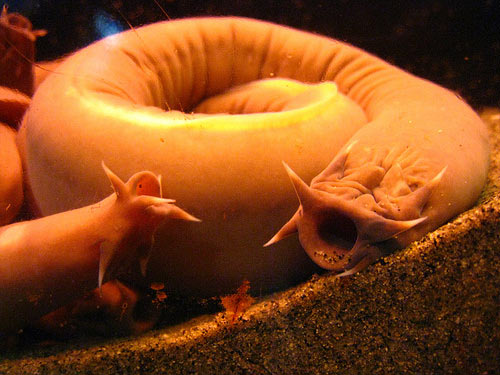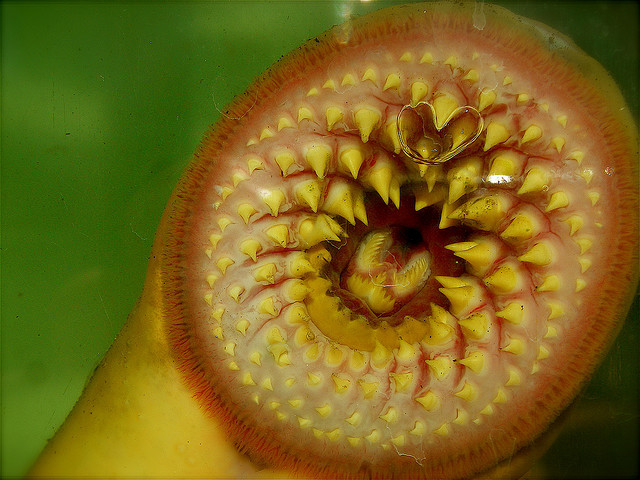 |
| mesa.edu.au |
 |
| theartfulamoeba.com |
 |
| jeb.biologists.org |
This adaptive-like immune system is the reason I bring up the hagfish. Researchers have found that parts of the hagfish immune system resemble the adaptive immune system of more advanced organisms like vertebrates. They believe this may lead to information on how the immune system evolved to eventually develop the immune system found in the vertebrates. The hagfish is estimated to have not changed much over 200 million years. This makes the anatomy and physiology of the organism primitive to more modern adaptations. The researchers first found signs of an adaptive immune system during an experiment in which they implanted skin allografts on different hagfish. They noticed that the hagfish were rejecting the allografts indicating that the immune system was attacking cells through memory of what was native to the host and what was not. Memory of the immune system is only found in the adaptive immune system.
To see whether the hagfish actually had an adaptive immune system, researchers studied the proteins that the hagfish used in its immune defenses. They found many proteins playing adaptive immune system-like roles. The one that was most closely related to the adaptive immune system of invertebrates was NICIR. They believed that this protein was the ancestor of the T-cells found in vertebrate immune systems. They found three different clones of the protein, and when they compared the sequences of these proteins to T-cell receptor-like proteins they found many similarities. They found that the proteins act as glycoproteins on cell membranes and can have similar functions to antibodies. This resembles the way a T-cell works since it has antibodies on its surface to identify foreign pathogens. This was an interesting discovery since it could help researchers understand how the immune system evolved to be how it is. This could help further our understanding on how the immune system works and help solve problems with immune system dysfunctions suck as auto-immune disease and more. This disgusting organism has proven to be more than just gross, it has proven to be a very useful tool in understanding how some advanced features came to be.
References
•Canadian
Science
Advisory Secretariat. (2009). Assessment of NAFO Division 3O and Subdivision
3PS Atlantic Hagfish (Myxine Glutinosa). Fisheries and Oceans Canada,
science advisory report 2009/042.
•Cooper,
M. D., & Adler, M. N. (2006, February 24). The Evolution of Adaptive Immune
Systems. Cell, 124(4),
815-822.
•Haruta,
C., Suzuki, T., & Kasahara,
M. (2006). Variable Domains in Hagfish: NICIR is a Polymorphic Multigene
Family Expressed Preferentially in Leukocytes and is Related to Lamprey
TCR-like. Immunogenetics, 58, 216-225.
•Keith,
C. (2006, December). Atlantic Hagfish. Status of Fishery Resources off
the Northeastern US, resource evaluation and assessment
division.
•Khalturin,
K., Panzer, Z., Cooper, M. D., & Bosch, T. C. G. (2004). Recognition
Strategies in the Innate Immune System of Ancestral Chordates. Molecular Immunology, 41,
1077-1087.
•Powell,
M. L., Kavanaugh,
S. I., & Sower, S. A. (2005). Current Knowledge of Hagfish Reproduction:
Implications for Fisheries Management. Integrative and Comparative
Biology, 45, 158-165.
•Subramanian,
S., Ross, N. W., & MacKinnon, S. L. (2008). Comparison of the Biochemical
Composition of Normal Epidermal Mucus and Extruded Slime of Hagfish (Myxine
glutinosa
L.). Fish & Shellfish Immunology,
25,
625-632.
•Suzuki,
T., Shin-I, T., Kohara, Y., & Kasahara,
M. (2004). Transcriptome
Analysis of Hagfish Leukocytes: a Framework for Understanding the Immune System
of Jawless Fishes. Developmental and Comparative
Immunology, 28, 993-1003.
I agree the hagfish is one gross creature! It is weird to think that we have evolved from this organism and that is why scientists study it. Also, I did not realize that this animal was the first branch to have an adaptive immune system. I thought that an adaptive immune system would have developed much earlier. Interesting!
ReplyDelete